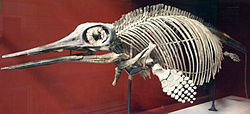Ophthalmosauridae
| Ophthalmosauridae Temporal range: Middle Jurassic-Late Cretaceous, 171.6–93.5 Ma |
|
|---|---|
 |
|
| Ophthalmosaurus icenicus skeleton | |
| Scientific classification | |
| Kingdom: | Animalia |
| Phylum: | Chordata |
| Class: | Reptilia |
| Order: | †Ichthyosauria |
| Clade: | †Baracromia |
| Family: |
†Ophthalmosauridae Baur, 1887 |
| Subgroups | |
| Synonyms | |
|
Opthalmosauria |
|
Opthalmosauria
Ophthalmosauridae is an extinct family of thunnosaur ichthyosaurs from the Middle Jurassic to the early Late Cretaceous (Bajocian - Cenomanian) of Asia, Australia, Europe, North America and South America. Currently, the oldest known ophthalmosaurid is Mollesaurus from the early Bajocian of Argentina. Named by George H. Baur, in 1887, it contains the basal taxa like Ophthalmosaurus. Appleby (1956) named the taxon Ophthalmosauria which was followed by some authors, but these two names are synonyms, Ophthalmosauridae has the priority over Ophthalmosauria.
Ophthalmosauridae is a node-based taxon defined by Ryosuke Motani (1999) as "the last common ancestor of Brachypterygius extremus and Ophthalmosaurus icenicus and all of its descendants". The definition he proposed for Ophthalmosauria was exactly the same. In this case both definitions are synonyms. The cladogram below follows the topology from a 2010 analysis by Patrick S. Druckenmiller and Erin E. Maxwell.
"Ophthalmosaurus" natans
...
Wikipedia
